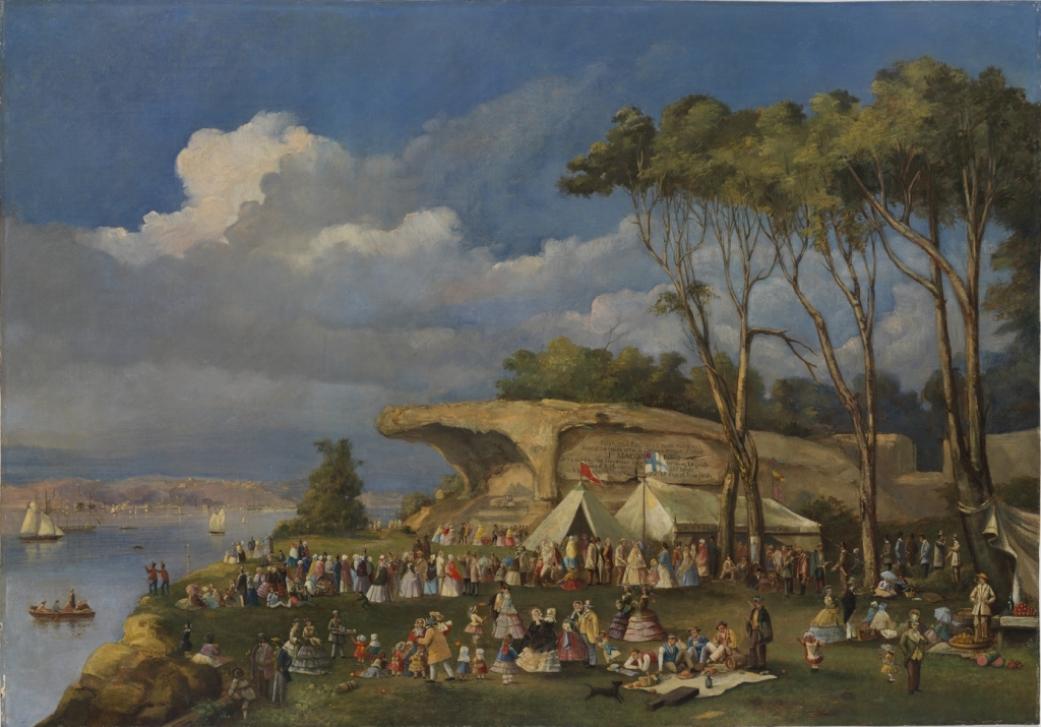January 21-27, 2024: Issue 610
The Australia Day Regatta Began As An Anniversary Day Regatta
Pittwater will be represented this year at the annual Australia Day Regatta with the Pittwater and 188th edition being conducted by Avalon Sailing Club on Pittwater, the delightful Boating Parade by members of the RMYC Broken Bay at Newport, with prizes for Best Dressed Boat, Captain and Crew, and everyone else who has a boat just getting out on the water to enjoy the best estuary in the world.
On Saturday January 27th the wonderful Woody Point Yacht Club will hold their annual Putt Putt Regatta, with a focus on fun.
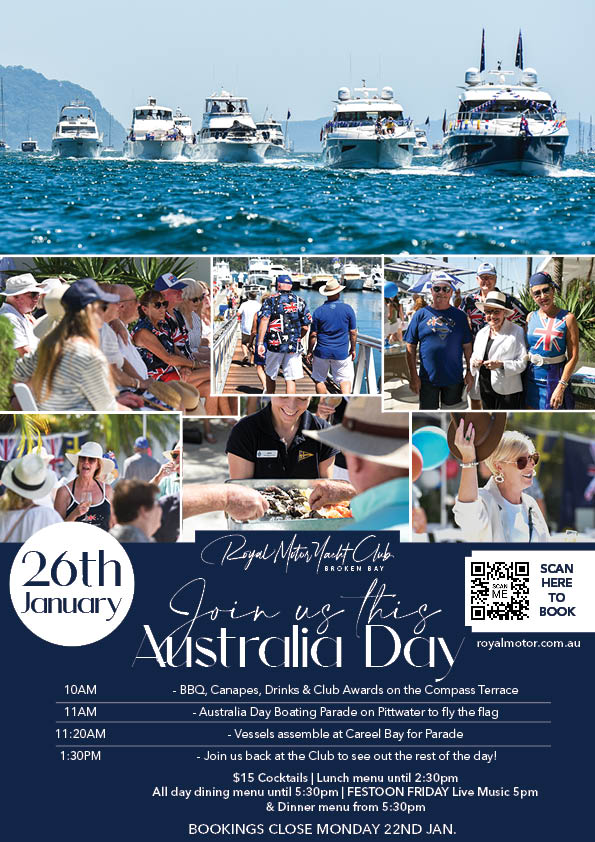
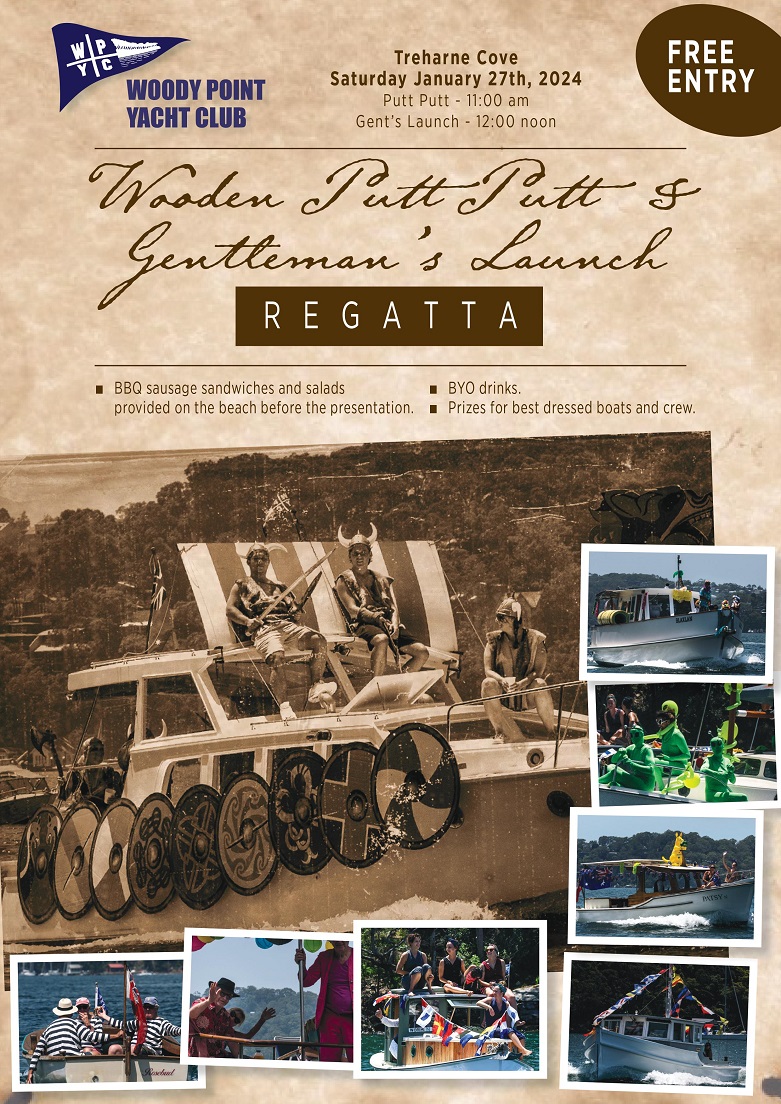
In 2014 Pittwater Online News ran a small insight into the rise of boat races and regattas in Sydney which new readers may not have had an opportunity to enjoy. With the long weekend coming up, a reprise may inspire finding an estuary side seat to enjoy the action and fun happening next weekend.
Initially the idea of a Regatta to celebrate the formation of a settlement in Sydney was not seen as a good idea as the population were mainly convicts who were here to be punished, not afforded fun. Fortunately a nation built on the sea ways, and comprising so many who either made their living from exporting or importing, had other ideas, and although the first Sydney Regatta was not run on the same date proclaimed as what is now called 'Australia Day', men will be men and when in their boats, more so:
In our report last week of the dinner given by JOHN THOMAS CAMPBELL, Esq. in honor of the Birthday of our late excellent GOVERNOR, General MACQUARIE , it should have been noticed that the fete was exclusively in revered remembrance of that occasion and not at all connected with the 34th Anniversary of the Establishment of Australasia. MAGISTRATE FOR THE WEEK—JOHN PIPER, Esq. (1823, February 13). The Sydney Gazette and New South Wales Advertiser (NSW : 1803 - 1842), p. 2. Retrieved from http://nla.gov.au/nla.news-article2181641
The first boat race of which we have any account was an amateur affair on May 16, 1818. It was won by Captain Piper, naval officer:
This day a Boat Race, from Bradley's Head in to the Cove (a distance of three miles and a half), took place, the boats starting at two o'clock, with the tide, and compleating the distance in 15 minutes. The number of competitors was four; viz. Captain Piper, Naval Officer ; Captain Lambe, of the Batavia ; Captain Johnston, of the Guildford ; and Captain Bell, of the Minerva; for a considerable sum, which was won by Captain Piper ; and we understand that a part of the winnings has been given to the Benevolent Fund for the Relief of the Poor. Sydney. (1818, May 16). The Sydney Gazette and New South Wales Advertiser (NSW : 1803 - 1842), p. 3. Retrieved from http://nla.gov.au/nla.news-article2177951
John Piper (20 April 1773 – 8 June 1851) was a military officer, public servant and landowner in the colony of New South Wales. Born in Maybole, Ayrshire Scotland, son of Hugh Piper, a doctor; his family came from Cornwall. He was commissioned as an ensign in the New South Wales Corps in 1791, and sailed on the convict ship Pitt, arriving in Sydney in February 1792.
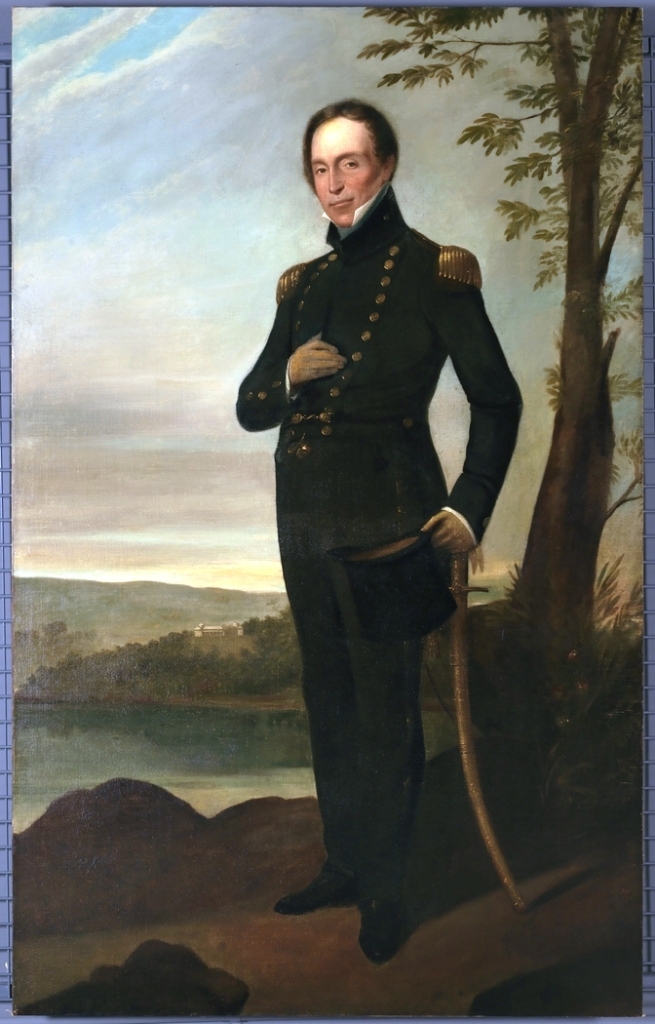
John Piper by Augustus Earle. Image No.: a9579002h courtesy Mitchell Library, State Library of New South Wales
He sailed for England in 1811, but resigned his commission and returned to Sydney in February 1814, as Naval Officer. In 1816 he married Mary Ann Shears, the daughter of two First Fleet convicts, who had already borne several children by him.
As Naval Officer, Piper was responsible for the collection of customs duties, excise on spirits, harbour dues, control of lighthouses, and crime on water. This post proved very remunerative, and he was able to purchase the property now known as Vaucluse House. He was granted 190 acres on what is now known as Point Piper and built Henrietta Pavilion at the large cost of £10,000.
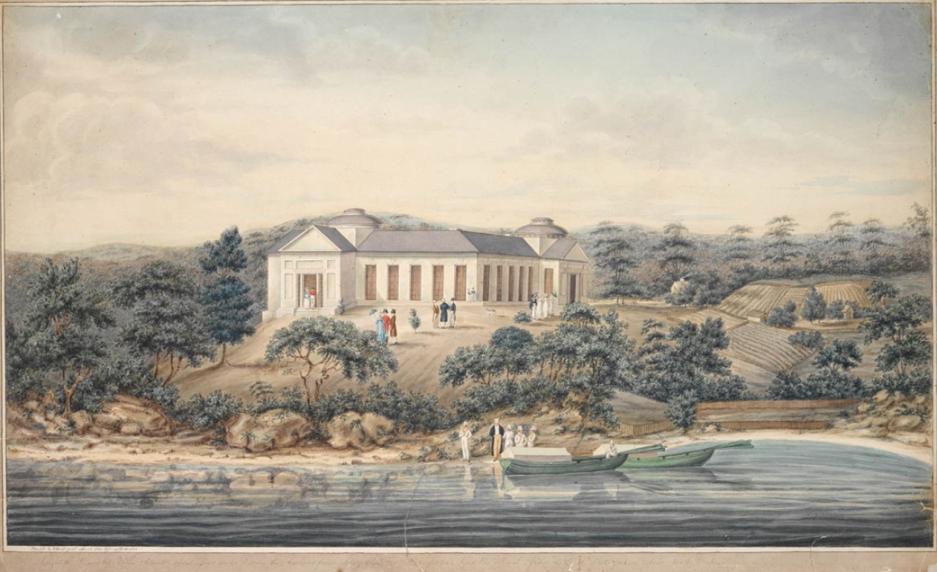
Henrietta Villa, built between 1816 and 1822, was the property of Captain Piper and most likely designed by Henry Kitchen. The house was named after Mrs Macquarie and became a symbol of progress in the colony. When this drawing was executed, the building was not finished as the verandah covering the long windows are absent. -- Reference: The Artist and the patron : aspects of colonial art in New South Wales / [compiled by] Patricia R. McDonald and Barry Pearce. [Sydney] : Art Gallery of New South Wales, 1988. Signed and dated at lower left in black ink, "Painted by R. Read junr. March 1820 Sydney N.S. Wales". Inscribed, probably in the artist's hand, beneath frame lines in pencil "Elizabeth Heneretta [i.e. Henrietta] Villa situate about four miles Down the Harbour from Sydney Cove the seat of John Piper Esqr. Naval Officer etc. etc. of Port Jackson New South Wales". Image No: a128862, courtesy State Library of NSW.
From Point Piper (the enviable and splendid seat of our worthy NAVAL OFFICER and FAMILY) a launch took place last week, of a novel kind. A fine barge, 43 feet in keel, pulling 10 oars and built by young Egan, a currency lad, was introduced to the domain of Neptune amidst the liveliest congratulations of a numerous company, purposely assembled to witness the scene. In the water she exhibits a perfect model of colonial ingenuity, and would do no discredit to more masterly powers. The happy owner has designated this new acquisition-" The Lady of the Lake." A company, consisting of between 20 and 30, if we are not mistaken, can be accommodated in this charming barge, which might have been appropriately named The Australian Yacht. Governor Macquarie. (1824, October 28). The Sydney Gazette and New South Wales Advertiser (NSW : 1803 - 1842), p. 2. Retrieved from http://nla.gov.au/nla.news-article2183320
This little insight is worth noting as building vessels here, and encouraging the colonial ship builders to do so, was to become a recurring theme for reports until after World War One and also as the first boat race ever held here is ascribed to the same 'worthy Naval Officer':
A Splendid Holiday Pastime. THE PLEASURES OF YACHTING.
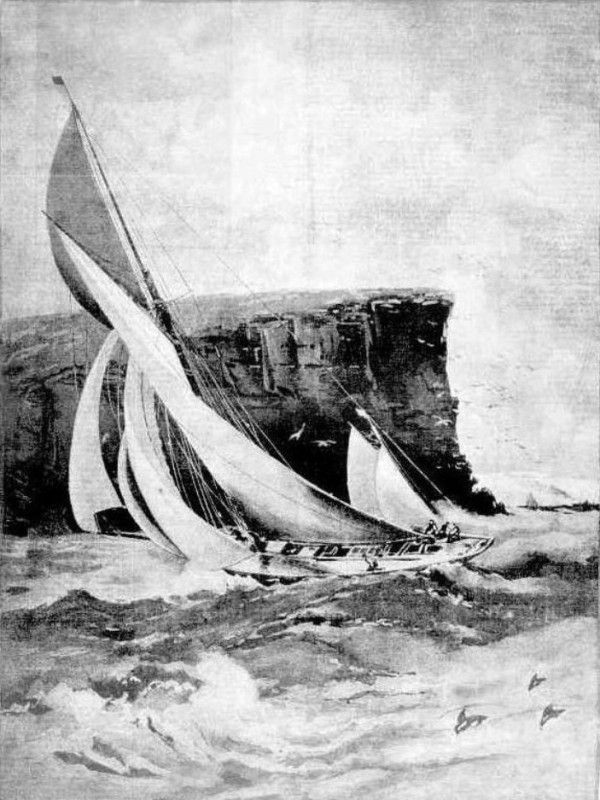 Among the various modes of enjoying Christmas, we have noted the rambles to the mountains, the lake, and the caves ; but there remains to be mentioned the pleasure which is so common, but which cannot be surpassed-that of yachting in the harbor. Not merely the harbor of Port Jackson, though that is delightful, but the yachting that is available in all our harbors, and which once enjoyed can never be forgotten. Can there be anything more enjoyable than the half excitement, half laziness of sitting in a well-found yacht with all comfortable surroundings, with a fresh breeze, the delicious flavor of sea water, and the gentle motion through the tiny waves? One feels inclined to leave all care behind, and to live only for the present. It is THE LOTUS EATER'S DREAM over again. But all need not be of this peaceful character. The yachtsman may, if he chooses, and if he is confident in his craft-and what true seaman is there who does not love his vessel-venture out to sea, despite the caution of old Horace, and brave the dangers of the deep. He does not care for a mere fishing excursion outside tho heads. That pursuit is beneath him. What he wants to do is to see how his yacht will behave in a rolling sea with a stiff breeze. His delight is in his seamanship. What is fish to him, or he to fish? There is finer fun than fishing.
Among the various modes of enjoying Christmas, we have noted the rambles to the mountains, the lake, and the caves ; but there remains to be mentioned the pleasure which is so common, but which cannot be surpassed-that of yachting in the harbor. Not merely the harbor of Port Jackson, though that is delightful, but the yachting that is available in all our harbors, and which once enjoyed can never be forgotten. Can there be anything more enjoyable than the half excitement, half laziness of sitting in a well-found yacht with all comfortable surroundings, with a fresh breeze, the delicious flavor of sea water, and the gentle motion through the tiny waves? One feels inclined to leave all care behind, and to live only for the present. It is THE LOTUS EATER'S DREAM over again. But all need not be of this peaceful character. The yachtsman may, if he chooses, and if he is confident in his craft-and what true seaman is there who does not love his vessel-venture out to sea, despite the caution of old Horace, and brave the dangers of the deep. He does not care for a mere fishing excursion outside tho heads. That pursuit is beneath him. What he wants to do is to see how his yacht will behave in a rolling sea with a stiff breeze. His delight is in his seamanship. What is fish to him, or he to fish? There is finer fun than fishing.
And when, after a glorious outing, he returns, rounding the heads into Sydney Harbor, with the feeling that whoever may have enjoyed an outing, no pleasure can be greater than his own.
People in Sydney have taken to yachting just as ducks take to water. It seems to be their natural element. Of course, only the wealthier classes are able to present the lovely boats which are the yacht man's beau-ideal. But in the humbler walks of life everybody who can manage to secure a boat with a sail, delights in taking his little cruise, although, unfortunately, these trips have been only too often fatal in their results, owing to ignorance or carelessness of management. No misfortunes daunt the people. The experiments are repeated and many a day’s pleasure might be recorded or obtained from
The HAPPY BOATING EXCURSIONS on the harbor. Not that every sailing boat is a yacht. The "swell " yachtsman looks down, with proud contempt, upon the little craft which makes its clumsy way along; but to those who use the sail the boat is for the time being as much a yacht to them as the finest little clipper that skims the surface of the waves. They get pleasure out of their trip: and pleasure is the summit of human existence. Therefore, in this respect the poor and the rich are on an equal footing; while the sea knows no difference.
Now, it may be interesting to go back for a while into the history of yachting. The first mention we have of it in England is in the year 1604, when a yacht was built by the King's shipwright for Henry, eldest son of James I. But the idea was taken from the Dutch, and probably came from the Venetians or the Genoese. However, after the construction of this vessel yachting became a fashionable occupation among the nobility. It was taken into royal favor for another reason. The yachtsmen were found to be remarkably good sailors, and therefore available for the navy; while their education did not cost the state anything. Consequently, they were held in high favor, and allowed various privileges-such as refitting at the Royal Navy yards, and they were permitted to fly the royal ensign and a special flag. This is the origin of THE PRIVILEGES in regard to flags, and the recognition of yacht clubs, accorded in the present day. The oldest club in the United Kingdom is the "Royal Cork," which existed under the name of the "Water Club of Cork "as early as 1720. Next came the Royal Yacht Squadron founded in June, 1815 (the month of the Battle of Waterloo), the headquarters of which were, and are, at Cowes, in the Isle of Wight. Then the Royal Thames Yacht Club was founded in 1823; and after that the names of the clubs are legion. Steam yachts were afterward introduced ; but, although, in some respects they may be considered to be of the same class as the sailing yachts, no true yachtsman will like them. They may be well enough in their way; but they look far too much like business to be acceptable.
We come now to our own country. The first boat race of which we have any account was an amateur affair on May 16, 1818. It was won by Captain Piper, naval officer. The course was 3 ½ miles from Bradley's Head into Sydney Cove; and the time was 15min. The first regatta in Port Jackson took place on April 27, 1828. But yachting was not brought specially into notice until the year 1838, when MR. JAMES MILSON, of North Shore, constructed a boat which, though originally intended for drawing wood to market, proved to be exceedingly fast and weatherly. This boat was the pioneer yacht of Australia; and the "Friendship" (for that was her name) led many a young Australian to ' fry to turn out something like her. No one knows exactly what became of this favorite old yacht. More's the pity, because her remains ought to be canonised for the benefit of modern yachtsmen. Mr. Milson continued his career for years as a successful yacht owner and builder; but a change came with the appearance, about 1850 of THE "ECLIPSE."
This boat was built under strict secrecy by Mr. P. J. Holdsworth, at Pyrmont, to the order of Dr. Atkins son. She defeated the old style of boats easily, and for years held her own. It is not necessary to follow up the history of yachting from that time. Many alterations have been introduced, and improvements made, in the style of building. Yachting is now fairly reckoned among our national ports and in any inter colonial contest the yachtsmen of Port Jackson can hold their own. But it is not the excitement of sport as much as the pleasure of the pursuit which will always make yachting one of the many luxuries of Sydney Harbor. A PLEASANT WAY TO SPEND A HOLIDAY-YACHTING IN SYDNEY HARBOR. (See letterpress on page 17;) A Splendid Holiday Pastime. (1889, December 21). Australian Town and Country Journal (NSW : 1870 - 1907), p. 17. Retrieved from http://nla.gov.au/nla.news-article71127041
The first Regatta in Sydney was actually held Saturday 27th of April, 1827:
A GRAND regatta, (the first public aquatic gala that has ever taken place in Sydney) is appointed for tomorrow. The Hon. Captain Rous, of H. M. S. Rainbow, Lieutenant Carnac, of H. M. S. Success, and other gentlemen, have made up a subscription purse of fifty dollars, to be sailed for in open boats not measuring more than 30 feet keel, to start from Bennelong's Point, and proceed down the harbour, round the Sow and Pigs, and return to a boat moored off the Cove. This display of nautical skill will be succeeded by a rowing match, for private boats not pulling more than four oars, for a purse of twenty dollars; to start from the above Point, and pull one mile to the eastward of Pinchgut and return; and lastly, a prize will be given to licensed watermen. The sporting boats to have distinguishing colours. DOMESTIC INTELLIGENCE. (1827, April 27 - Friday). The Monitor(Sydney, NSW : 1826 - 1828), p. 5. Retrieved from http://nla.gov.au/nla.news-article31758378
The First Australian Regatta.
Saturday was fixed on, as it closed the week, to conclude the week's sports. Under the auspices of Captains STIRLING and Rous, of H. M. ships Success and Rainbow, three aquatic Races were set on foot, and time just allows the enumeration of these novel but highly interesting, and comparatively innocent amusements.
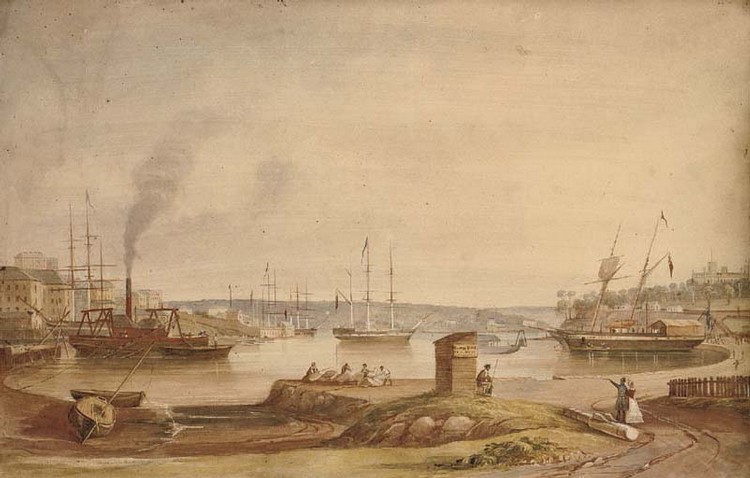 The first Race was a Rowing Match for Sweepstakes of 20 Spanish dollars, for which the following boats started :-Captain Rous' Mercury; Captain Rous' Centipede; Lieutenant Carnac's Maria ; Mr. Scott's Australian Lass; Lieutenant Cooling's Cock-burn; and Colonel Dumaresq's Fancy.
The first Race was a Rowing Match for Sweepstakes of 20 Spanish dollars, for which the following boats started :-Captain Rous' Mercury; Captain Rous' Centipede; Lieutenant Carnac's Maria ; Mr. Scott's Australian Lass; Lieutenant Cooling's Cock-burn; and Colonel Dumaresq's Fancy.
Right: Sydney Cove from the new Circular Quay looking North. 1844, Frederick Garling.
A preparative gun was fired from the Success a few minutes after 12, for the various antagonists to assemble; and, in ten minutes after, the discharge of a second gun gave the signal for action. They started from Sydney Cove, and rounded a boat moored off Pinchgut Island, which they passed from the Southward to the Northward, and ended off Sydney. This Race was cleverly won by the Mercury, belonging to the Honorable Captain Rous; and when she came in, the yards of the Success being manned, the naval heroes gave three cheers; the Band of the 57th at the same time striking up cheerily.
The second Race was a Sailing Match for a Purse of 50 Spanish dollars, given by the Officers of H. M. ships Success and Rainbow, added to a Sweepstakes of 5 dollars each. About two a similar signal was given from the Success, and the following boats started a short time after:
Captain Rous' Australia; Lieutenant, Cooling's Ro Reby ; Mr. Milroy's Ellen; Mr. Gray's Go-along; Mr. Nicholson's Hannah; Mr. Egan's Australian; Mr. J. Campbell's Model; and Captain Barnett's Rosanna. The prescribed distance was to go round the Sow-and-Pigs. The wind was rather light, which made against some of the boat's. The victory, however, was gained by Lieutenant Preston's Black Swan.
The third Race was a Rowing Match, for 20 Spanish Dollars, given by the Officers of H. M. Ships Success and Rainbow. Eight boats started for the prize, taking their departure from Dawes' Point, rounding Pinch-gut Island, and returning to the place whence they set out. It was won by Black Boy.
We regret that leisure does not allow us more to particularise these amusements; for of all the sports of which we know, this is one that is attended with emulation, abstracted from the semblance of cruelty ; and if horse-racing be really attended with good results, as regards the breed of animals, we certainly are of opinion, that such sports as those of a Regatta kind might be mantained annually ; inasmuch as boat-builders would be benefited; watermen would be induced to keep comfortable and genteel boats; and a particular branch of useful trade would be promoted. We trust therefore, that the first, will not prove the last, Regatta of New South Wales.
The Success and Rainbow were crowded with Ladies and Gentlemen. On board the former ship, the Band of the 57th was adding to the interest of the scene, and the Ladies during the intervals of the Races, were engaged by the gentlemen to while away the lingering moments on " the light fantastic toe." Captains STIRLING and ROUS, as well us their Officers, did all in their power to contribute to the happiness of their guests, especially the Ladies, of whom there was no small number.
Dawes' Point and Macquarie Fort were crowded with spectators of all ranks and denominations. The harbour was thickly strewed with floating vehicles of all shapes, dimensions, and colours. In fact it does not come within our recollection that such another gratifying exhibition presented itself to the view of the Australian Public, since the day that venerated MACQUARIE for ever bid adieu to the rising empire of Australia.
Ere we close, it is nothing more than justice to add, that Mr. Nicholson, the worthy Master Attendant, who was appointed Judge for the day, is amply entitled to the thanks of all who were gratified, for the trouble and interest he took in promoting and executing the pleasures of the day. The First Australian Regatta. (1827, April 30). The Sydney Gazette and New South Wales Advertiser (NSW : 1803 - 1842), p. 2. Retrieved from http://nla.gov.au/nla.news-article2188128
A very successful regatta in February 1836, and a growing population of now affluent ex-convicts who were proud of the new land they now lived in, combined in a wish to acknowledge the founding of their new home and the first regatta of an "anniversary' ilk took place in 1837:
NEWS OF THE DAY. REGATTA.
The Regatta for to-morrow, the 26th, is arranged to come off in the following manner; The First Race to be between the first class sailing boats-of 16-feet keel and upwards. Entrance, one guinea; the first boat is to, receive ten guineas; the second boat five guineas. The Second Race, between the second class sailing boats under-16 feet keel.- Entrance one pound ; first Boat into receive ten guineas, the second boat five guineas. The Third Race, between whale boats. Entrance one guinea; first boat in to receive ten guineas; the second boat five guineas. Fourth Race, between gigs. Entrance one pound; first boat in to receive ten guineas ; the second boat five guineas. Fifth Race, is to be a waterman's sculling match of three heats round Pinchgut Entrance five shillings; the first boat in to receive ten guineas; the second boat four guineas ; and the third boat one guinea. All boats were to be entered at the Dock Yard by ten o'clock this morning. Upwards of £70 had, a week back, been obtained in aid of the purses, and we doubt not but that the day's sport will be such as was never before witnessed in this Harbour. NEWS OF THE DAY. (1837, January 25). The Sydney Monitor(NSW : 1828 - 1838), p. 2 Edition: EVENING. Retrieved from http://nla.gov.au/nla.news-article32154673
THE HARBOR AS IDEAL PLAYGROUND FOR WHITE WINGS - PIONEERS~OF THE SPORT- REGATTAS OF SIXTY YEARS AGO, AND THEIR MISHAPS
By H. C. PACKHAM.
''Heave O, my lads, and hearty,
The rolling seas we'll rove;
From port to port we'll wander,
Then steer for Sydney Cove."
In the old days, when the waters of Rushcutters Bay ebbed and flowed to and from the margin of West's Bush, and blacks made their camps at Rose Bay, and the surrounding country was dense with scrub and bracken, when St. Leonards reigned alone on the northern shore of the harbor, and the territory between the picturesque Parramatta and the fairy bowers of Lane Cove was rough, and unknown land save to a few, yachting was to Sydney-siders the favorite sport and the most popular recreation. And throughout the succeeding years which have witnessed the transformation of the bush lands into the populous suburbs of the harbor city the wholesome sport of sailing has claimed its fair share of devotees, notwithstanding the call of numerous other pastimes with all their excitement and attraction. And surely it could not have been otherwise, for Sydney harbor, with its islets, its estuaries and coves, and almost countless little bays, is a yachtsman's paradise. Many accounts have been written of this wonderful harbor, but it has never been adequately described. As no painting could present the whole of it, with its hundreds of miles of foreshores, so no mere pen picture could do it justice. Since Phillip sent his famous dispatch to Lord Sydney : 'I have had the satisfaction of finding the finest harbor in the world, in which a thousand sail of the line may ride in perfect safety,' this marvellously beautiful work of Nature has been a favorite theme with poets and writers of prose; but, like the personality mirrored in a charmingly expressive face, it defies Art. Those of us who have lived any considerable length of time by the shores of Port Jackson may imagine the wonder of Phillip and his men when they first viewed the scene in its virgin splendor. Less than thirty years ago much of the northern shore, from Middle Head to Neutral Bay, was still in its native state, while there were few' buildings between Point Piper and the Hornsby light. Garden Island remained a bijou spot, in keeping with its name, and the bays beyond Balmain preserved their indigenous growths. But late years and the hand of man have wrought a mighty change. And yet, changed and all as it is, the noble harbor maintains its reputation for beauty.
GUNS AND FISHING TACKLE.
In the long ago the country for miles around Sydney abounded in wild fowl, and the yachtsmen of the day on their excursions carried their guns as well as their fishing tackle, and the boats would return laden with game and fish. Between Manly and Pittwater was a great hunting ground, and the swamps around Botany provided excellent 'shooting. The earliest yachting in the harbor was furnished by the boats of the ships which visited the port. For racing purposes these boats were fitted with false keels to enable them to stand up against a breeze, and the ships' crews, who originated the competitions, went to no end of trouble to increase the sailing qualities of their craft. Short races in the neighborhood of the vessels were the order of the day, but these supplied salubrious sport and good-fellowship. The first privately-owned yacht in Sydney, we are told, was built for Mr. Robert Campbell, of Campbell's Wharf, in 1827. She was an open boat of about three tons, and carried sliding gunter sails. She was soon followed by the Eclipse, a 6-tonner, built for another member of the Campbell family, and a capacious pleasure boat.
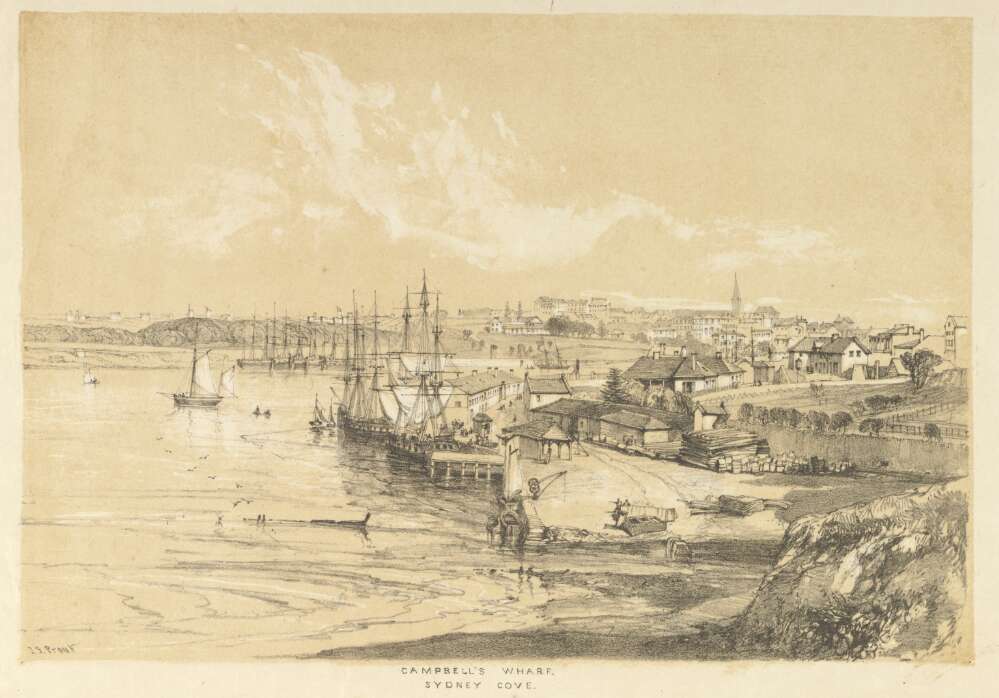
Campbell's Wharf, Sydney Cove, 1842, courtesy National Library of Australia
By 1836 there was quite a flotilla of pleasure and rowing boats, and in that year an association of yachtsmen was formed. Among the original members of this historic association were Mr. Barton Bradley, who owned a boat named the Swallow, and who was the commodore; Mr. James Milson, whose racer in those days was the Sophia; and Mr. John Ritchie, who owned the Ariel.
WHERE CROWDS GATHERED.
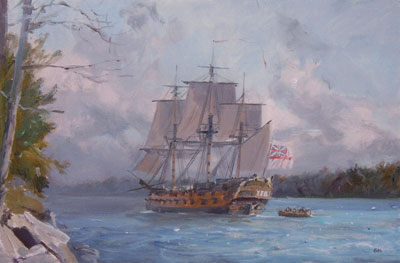 But the first official regatta eventuated as far back, as April 28, 1827, under the auspices of Captain Stirling, of H.M.S. Success, and Captain Rouse, of H.M.S. Rainbow. The Success was the flagship, and the band of the 57th Regiment, then stationed in New South Wales, played dance and other music on board for the pleasure of the guests of that auspicious day. It is stated that crowds of people — what a handful they would seem now — collected on Dawes Point and Mrs. Macquarie’s Chair to witness the races. The program consisted of one sailing and two rowing races. The first of these was over a course from Sydney Cove, round the Sow and Pigs and back, and the breeze was so light that the race, which was won by Lieutenant Preston's Black Swan, was not finished till late in the evening, and after most of the holiday-makers had returned to their homes. Among the possessor of well known Sydney- names at that regatta of the past, and the early days of this State, were Dr. Bland, Captain Piper, Mr. D'Arcy Wentworth, Captain Green, Mr. Richard Jones, and Captain Boyd.
But the first official regatta eventuated as far back, as April 28, 1827, under the auspices of Captain Stirling, of H.M.S. Success, and Captain Rouse, of H.M.S. Rainbow. The Success was the flagship, and the band of the 57th Regiment, then stationed in New South Wales, played dance and other music on board for the pleasure of the guests of that auspicious day. It is stated that crowds of people — what a handful they would seem now — collected on Dawes Point and Mrs. Macquarie’s Chair to witness the races. The program consisted of one sailing and two rowing races. The first of these was over a course from Sydney Cove, round the Sow and Pigs and back, and the breeze was so light that the race, which was won by Lieutenant Preston's Black Swan, was not finished till late in the evening, and after most of the holiday-makers had returned to their homes. Among the possessor of well known Sydney- names at that regatta of the past, and the early days of this State, were Dr. Bland, Captain Piper, Mr. D'Arcy Wentworth, Captain Green, Mr. Richard Jones, and Captain Boyd.
FIRST OF LONG LINE.
The first Anniversary Regatta was held in 1837, when the Colony reached its 49th year. The program contained races for both first and second class sailing boats. A. Mr. Looke was the most successful yacht builder in these parts in those times. He built Sophia for Mr. Milson, and a boat of the sliding gunter type, called North Star, for Mr. Harry Sawyer. These two boats were the cracks of the harbor. At the first regatta Sophia carried her owner's colors to victory, but the following year her rival turned the tables on her and won the big event. The first big yacht to make her appearance in Port Jackson was the Petrel, a roomy schooner, built by Brown, of Neutral Bay, in the thirties, for Messrs. Lord and Evans, of the Bank of New South Wales. She was staunch enough for ocean voyages, and her owners frequently took her cruises along the coast. She was not a racer; indeed, there were no boats at first to compete with her, so she cruised in and out of the bays of the port, and went her voyages on the Pacific seeking :
'A wet sheet and a flowing sea,
A wind that follows fast
And fills the white and rustling sails,
And bends the gallant mast.
WHEN HAIDEE CAPSIZED.
In the regatta of 1839 no fewer than seventeen boats started in the first-class yacht race. These included Haidee, owned by Mr. George Thornton. When the yachts were off Shark Point they were struck by a southerly buster, and Haidee capsized and sank. Five out of her crew of six, including Mr. Thornton's brother, were drowned**. About the same year another boat was capsized off Bradley's Head with fatal results. So in those early days the harbor claimed its toll, and local yachting found no beginnings without a heavy cost. It was in 1840 that Green, of the Parramatta, built the Friendship, she was a 12-ton decked boat, and meant for cruising, but Mr. James Milson bought and raced her, and in her day she was a champion. In the period of her success she was sliding-gunter rigged, but afterwards Mr. Milson converted her into a cutter, and put a cabin in her to improve her for cruising purposes. The new rig, however, interfered with her speed, and finally she had to forfeit pride of place to Mr. Thornton's Champion.
The early forties welcomed another schooner, the Pearl, a 40-tonner, to the fleet of Sydney's pleasure craft. She was built for Messrs. Randolph Want and J. H. Challis, and was a splendid specimen of the boat-builder's skill. In her her owners went far afield, and used to venture as far south as Wollongong and the shores of Illawarra. By the advent of the fifties there was a considerable fleet of yachts in the harbor, and sailing was the first among the local sports. In '55 Mr. Milson, who had been on a visit Home, as the Old Country was then called, returned, and with him he brought the Mischief, a 12-ton cutter. This was the first English built yacht to sail the waters of Port Jackson, and she came out with a reputation for speed, for she had won many races before her voyage south. And in Sydney she was famous. The next importation was the Surprise, which was owned and races successfully by Mr. Burt. Another boat from across the seas that showed up about the same time was the Presto, of. 2 ½ tons. She was American — the first centerboard boat to grace the harbor. Later on Mr. James Milson had the first Era brought from England. She was shipped in frames, and pieced together in Sydney. Era's early rival, was a boat — the Annie Ogle — built by Captain Rountree. In the first race in which they met the breeze was light and variable, and the latter won. But later, when they met again in a good stiff blow from the north-east, Era proved her superiority.
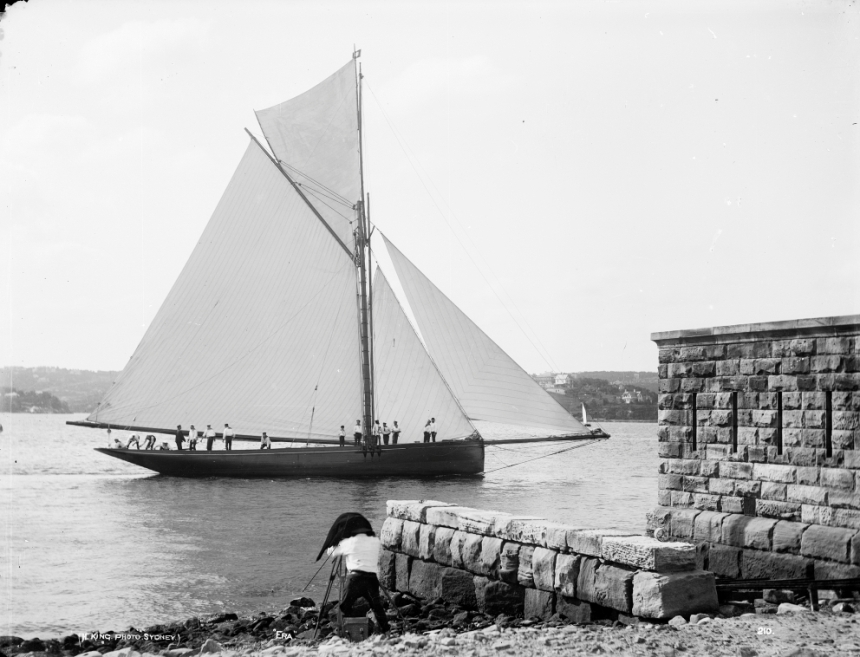
The Era - courtesy Tyrell Collection on Flickr - a Powerhouse museum project.
WHEN YACHT CLUB WAS FORMED.
In 1856 the Sydney Yacht Club was formed. Mr. Hutchison Brown was the first commodore. And so from the smallest of beginnings the yachting of Sydney harbor grew year by year till in the later 'fifties the fleet contained, besides the fine sailers already mentioned, boats such as Mr. Ross Donnelly's 40-ton schooner Boomerang, Mr. Weiland's English cutter Ariel, Mr. Ralph Owen's 25-tonner Sylph, Mr. Thornton's Avenger, a 28-ton schooner built in Brisbane, and sailed from Moreton Bay to Port Jackson, the English-built Enchantress, of20 tons, the Vivid, of 40 tons, and the 15-ton Why Not. Truly a fine showing for so short a period. And then, too, there was a fleet of small open boats of no mean proportions. These, then, were the substantial foundations of sailing as a sport and a recreation among our people. It is small wonder with such, and the great natural advantages afforded by the harbor, that Sydney ranks among the foremost yachting communities of the world. Genesis of Sydney Yachting. (1916, March 22). Referee(Sydney, NSW : 1886 - 1939), p. 16. Retrieved from http://nla.gov.au/nla.news-article121178528
The Haidee did not capsize in the 1839 Regatta - she won, and kept winning for almost 30 years after this - although a gentleman did fall from her in 1883 and drowned then - what really occurred in 1839:
The following is the order in which the boats came in : 1 — FOUR-OARED GIGS. Nicholson's Sisters 10 guineas. 2. SAILING BOATS. Thornton's Haidee- The Cup & 10 gs. Wealand's Ariel - 10 guineas
The owners of the Haidee, the winner of the first class prize for sailing boats, presented the cup to Mr Underwood, the builder of the boat, last evening.
We are sorry that there was one fatal accident which contributed to throw a degree of gloom upon the days amusement. This was the drowning of Mr Cavendish and his Sister, whose boat was upset near Bradley's head. An account of this lamentable occurrence will be found in another column. We have been requested to contradict the report which is in circulation that the winning boat Haidee, refused to proffer their assistance to save the life Mr Cavendish and his sister, although they were quite near them, when the lamentable accident occurred. We have been informed that Mr Thornton (the owner of the boat) was on board at the time, and has publicly stated that he neither saw or heard of the melancholy transaction until the boat reached the winning post. THE ANNIVERSARY REGATTA. (1839, January 29). The Australian (Sydney, NSW : 1824 - 1848), p. 2. Retrieved from http://nla.gov.au/nla.news-article36860064
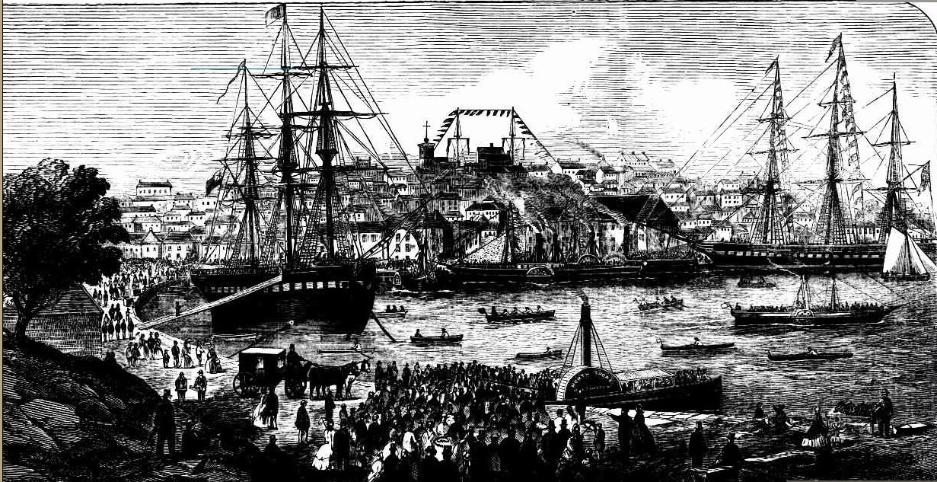
Above: THE CIRCULAR QUAY ON ANNIVERSARY DAY. SCULLING RACE FOR THE CHAMPIONSHIP. (1866, February 16). Illustrated Sydney News (NSW : 1853 - 1872), p. 8. Retrieved from http://nla.gov.au/nla.news-article63512782
THE YACHT RACE ON ANNIVERSARY DAY.
THE spirited contests which have several -times this season taken place between the second-class yachts of the R.S. Y. Squadron, have given rise to much difference of opinion -respecting the merits of the several vessels. Each in turn have won a race, but not a few have persistently maintained that the Haidee well sailed was Queen of the Fleet.. JChose who held this opinion were gratified by her winning the race which our illustration .represents. The entries were-Haidee, 14 tons, Mr. Wilshire ; Ella, 11 tons, Colonel Richardson ; Nereid, 12 tons, Messrs. Fairfax and Lassetter ; Australian, 5 tons,. D. Sheehy. Of the latter nothing need be said (more than that she is an extraordinary fast lacing machine, and when her owner pitted her against the other vessels he far overshot his mark, and she never had a chance, not- withstanding the fact that she was first off at the start, closely followed by Ella, Nereid next, and Haidee last. In going down to Goat Island, Haidee closed up with Ella, and in working down to Manly weathered on the fleet; Nereid in close attendance, but losing her topmast she was speedily out of the race. Haidee improved her position in running home, rounding the flagship about two minutes ahead. The Ella stuck well to her until Bradley's was passed, when Haidee's -superiority in a wind again became manifest, and the race was never again in doubt. She finished four minutes ahead of Ella, and eighteen minutes ahead of Australian. The winning vessel was built this season by Lomax, of Balmain, and is his first attempt at yacht building, Ella was built last season by Sheehy, for I .Colonel Richardson, and Nereid this year by Langford, for her present owners.
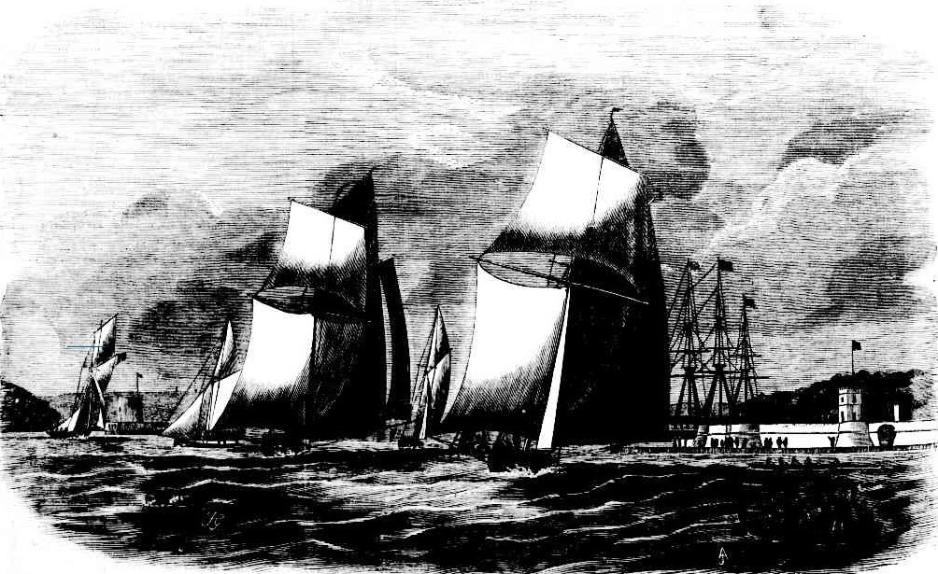
THE ANNIVERSARY REGATTA.-THE HAIDEE WINNING THE MINISTERIAL PLATE. THE YACHT RACE ON ANNIVERSARY DAY. (1867, February 16). Illustrated Sydney News (NSW : 1853 - 1872), p. 5. Retrieved from http://nla.gov.au/nla.news-article63513337
ANNIVERSARY REGATTA, 1860.
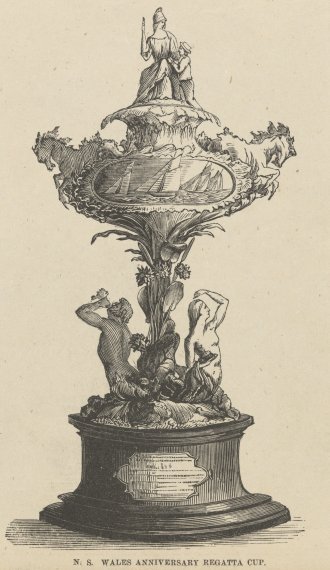 FOREMOST amongst the festivities of yesterday stood the Regatta ; and assuredly a more successful or better conducted one has never been witnessed in the waters of Fort Jackson. Tho whole affair, from first to lost indeed, redounded to the credit of the Yacht Club and those other gentlemen who participated in the management of the day's business. The festival was appropriate in every respect, and well worthy of the important event which it was designed to commemorate. From an early hour in the morning, a continuous stream of holiday folk, all dressed in their best attire, were to be seen wending their way toward those various beautiful spots along the shores of the harbour whence a prospect of the sports was to be secured ; and, as usual on such occasions, Dawes' Point, Fort Macquarie. Lady Macquarie’s Point, and other well-known and picturesque localities, were crowded with spectators, citizens of every grade and position, mingling together, and joining harmoniously in the celebration of our national holiday.
FOREMOST amongst the festivities of yesterday stood the Regatta ; and assuredly a more successful or better conducted one has never been witnessed in the waters of Fort Jackson. Tho whole affair, from first to lost indeed, redounded to the credit of the Yacht Club and those other gentlemen who participated in the management of the day's business. The festival was appropriate in every respect, and well worthy of the important event which it was designed to commemorate. From an early hour in the morning, a continuous stream of holiday folk, all dressed in their best attire, were to be seen wending their way toward those various beautiful spots along the shores of the harbour whence a prospect of the sports was to be secured ; and, as usual on such occasions, Dawes' Point, Fort Macquarie. Lady Macquarie’s Point, and other well-known and picturesque localities, were crowded with spectators, citizens of every grade and position, mingling together, and joining harmoniously in the celebration of our national holiday.
Right: 1853 Anniversary Regatta Cup, Image No.: an8004025, courtesy National Library of Australia.
The weather was all that could be wished by the most enthusiastic admirer of a fine day. The wind was, perhaps, a little too strong-boisterous, indeed, so far as the skiff races went-but admirably adapted for the sailing matches. Hence tho additional interest created in tho first-class yacht race-the issue of which, by the Way, took many by surprise, the general impression prior to the start being that the Annie Ogle would carry off the prize. Mr. Dean's lucky star was again in the ascendant, however, and he succeeded in adding another to the many handsome trophies of success which he previously possessed. The Champion Race in wager boats proved a comparative failure, three of the competitors capsizing shortly after starting. In the water men's race (one of the best contests of the day) the ex-champion, M'Grath, defeated the Melbourne puller, De Ward, in gallant style, although in the four-oared gig match, the latter, in company with White, Candlish, and Day, succeeded in wresting the palm from the natives. The whaleboat race was, however, the great event of the day, and terminating as it did in a victory for the Mulhalls crew, considerably softened down the defeat in the former case. So far as the issue of the regatta is concerned, it is satisfactory to notice that the prize money was pretty fairly distributed, the various wharves being represented in the list of winners. Through the kindness of the A. S. N. Company the committee (to whom every praise is justly due) were favoured with the use of the steamer Governor-General as flagship, and, with the attraction of the military band, it is hardly necessary to state that the company on board, numbering at least four hundred ladies and gentlemen, were enabled to enjoy themselves moat thoroughly.During the early part of the morning, his Excellency the Governor-general honoured the committee with his presence on board the vessel, together with several members of his family, and on leaving complimented them on the admirable arrangements which they had made. Sir William subsequently took a turn up and down the harbour, watching with apparent interest the gig-race and other matches. While talking of the flagship, we must not omit to say a word or two of the splendid dinners prepared by Messrs. Hampton and Cunningham; a more elegantly furnished table we have rarely seen-the viands being of the very best description, and served up in a style which spoke well for the taste of the contractors. The charge, too, was reasonable, which is a consideration that is sometimes lost sight of on such occasions. In fact, in every sense of the word, the thing was a credit to those connected with it, and it is to be hoped so good an example will not be lost sight of in the future. Without pausing to chronicle all the little events which took place ashore and afloat, but simply contenting ourselves with recording the fact of the celebration being a marked success, we proceed to a detail of the various races, in the starting and superintendence of which Mr. G.Thornton acquitted himself to the satisfaction of all concerned. We should perhaps award a word of praise to Mr. Cowell and the water police, for their efficient service in keeping a clear course for the boats. This Was the only duty they had to perform, however, and it required little exertion, everyone readily assuring TO secure a fair field and no favour for the respective competitors. We append the result of the different matches, and trust that the same spirit of harmony which characterised them throughout may prevail in all future Regattas.
FIRST RACE.-For all dingies not exceeding 12 feet on the keel, to be pulled with a pair of sculls _ by youths fifteen years of age and under....
THIRTEENTH RACE. - For all bona fide whaleboats, pulling five oars, that have been used for or are actually fit for whaling purposes, and to be approved of by the committee. First prize, £50 ; second prize,£10. Entrance, £3 3s. Course, same as No. 3.
Susan - Light blue - George Mulhall ..... 1 Freak - Blue and white - R. Love ...... 2 No Joke - Dark blue - T. Day.
Opinion was strongly in favour of Day's crew consisting of himself, White, Candlish, Deward, and another), and the more so as the boat they used had the reputation of being very fast. She had only a few days since been imported from Tasmania. The London men got away with the lead, and on nearing Goat Island were considerably ahead. At this point, however, the Mulhalls put on steam, and gradually lessening the gap, went to the front, winning the best race of the day with ease ; the Freak coming in second about thirty lengths behind. The winning boat was cheered most vociferously as she passed the flag-ship. With respect to the defeated crew, it must be borne in mind that they had previously been pulling in other races, and coming to meet fresh men, it was not surprising that they were unsuccessful, even though having the best boat of the three.
ANNIVERSARY REGATTA, 1860. (1860, January 27). The Sydney Morning Herald (NSW : 1842 - 1954), p. 4. Retrieved from http://nla.gov.au/nla.news-article13035999
ANNIVERSARY DAY - Celebrations of the"Good Old Days."
By G. A. King.
Those of an older generation shake their heads when the Anniversary Day holiday is mentioned. "Today," they say, "Anniversary Day is just an ordinary public holiday, the same almost as others scattered plentifully throughout the year."
For many years, the Anniversary Regatta was by far the most important event of January 26, or of the day on which the anniversary of the founding of the first settlement at Sydney Cove was celebrated. Of recent years, however, the regatta has lost a lot of its former greatness, and as the old folk say, there is very little resemblance between the past and present methods of "keeping up" the anniversary.
In the very early days, what celebrations there may have been were purely official, and more or less private, because, apart from the military, the population of Sydney consisted mostly of prisoners, and they were not encouraged to "celebrate."
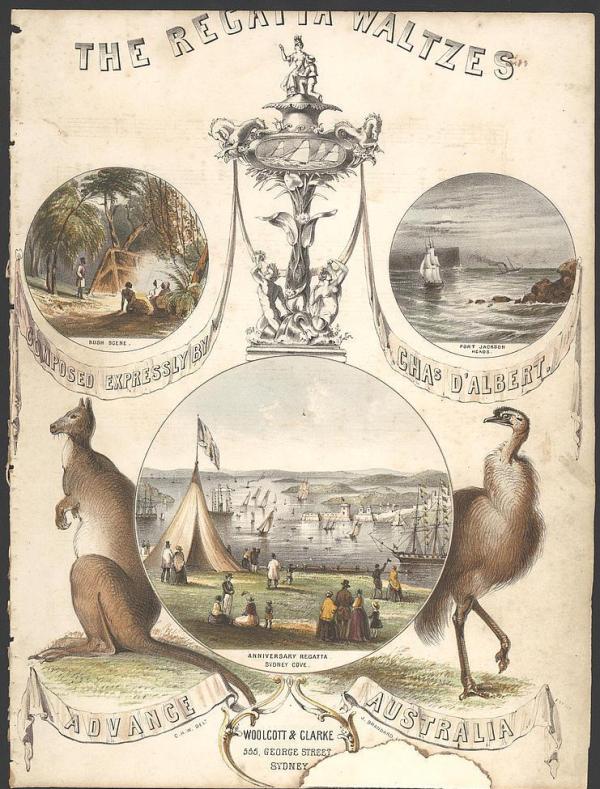 Twenty-nine years after Phillip formally established the settlement on January 26, 1788, appears the first public record of the commemoration of Anniversary Day. Down in Lower George Street, not far from the head of Sydney Cove, a dinner party was held at the house of Isaac Nichols, Sydney's first postmaster, to celebrate the anniversary of the colony.
Twenty-nine years after Phillip formally established the settlement on January 26, 1788, appears the first public record of the commemoration of Anniversary Day. Down in Lower George Street, not far from the head of Sydney Cove, a dinner party was held at the house of Isaac Nichols, Sydney's first postmaster, to celebrate the anniversary of the colony.
Right: The Regatta Waltzes - 1855, Image No.: an21991644, courtesy National Library of Australia.
The guests, about 40 in number, were "select." Dinner was on the table at 5 o'clock in the afternoon, and the party dispersed at 10 p.m. Loyal toasts were honoured, festive songs were rendered. It is also recorded that the party was "well gratified with the pleasure that the meeting had afforded," and the loyalty reached a climax when some verses, composed by Robert Jenkins, who presided, were sung, the first verse being:
When first Australia rose to fame,
And seamen brave explored her shore;
Neptune with Joy. with Joy beheld their aim.
And thus expressed the wish he bore: Rise, Australia, with peace and plenty crown'd.
Thy name shall one day be renown'd.
Macquarie's Gesture.
Governor Macquarie, pardonably vain and always alert, did not miss the significance of Isaac Nichol’s dinner of 1817, and there is in the following year a record of what is believed to have been the only occasion on which Government House was the scene of commemoration festivities. In the morning, the Governor reviewed the 48th Regiment; in the afternoon, he gave a dinner to the civil and military officers; and, in the evening, Mrs. Macquarie gave a ball.
"The Sydney Gazette" tells us that "we were particularly gratified with a likeness of Governor Phillip, executed by Mr. Greenway, the architect, which was suspended at one end of the room in a wreath supported by two banners, one being that of the late Vice-Admiral Phillip, and the other containing the inscription: 'In commemoration of the thirtieth anniversary of the colony of New South Wales, established by Arthur Phillip, whose virtues and talents entitle him to the grateful remembrance of his country, and to whose arduous exertions the present prosperity of the colony may chiefly be ascribed.'
After Macquarie's time, succeeding anniversaries met with little or no further official recognition of the kind described, because the civil and military gentlemen, who comprised the aristocracy, declined to have anything to do with the celebrations, and left them entirely in the hands of the emancipists, who, including Isaac Nichols, had orginated them.
Right: Anniversray Polke - 1853, Image No.: 6442810, courtesy National Library of Australia.
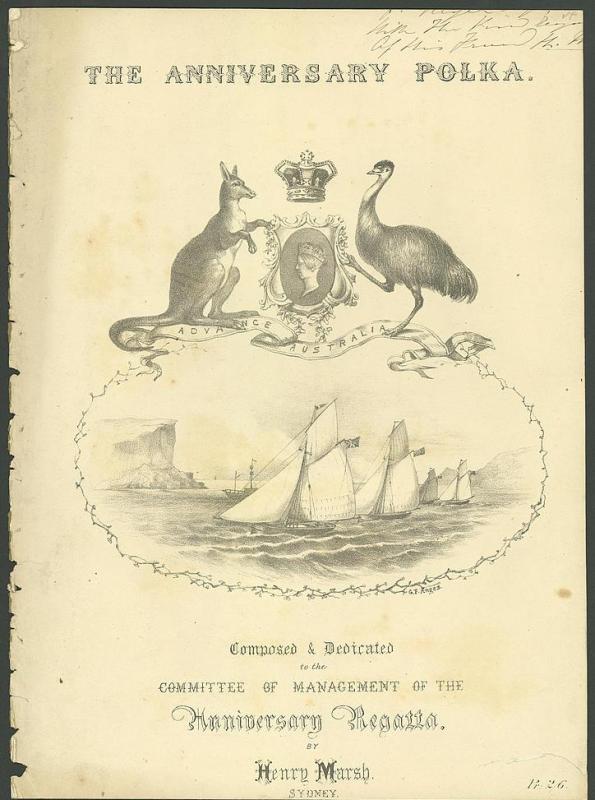 So we pass to the year 1838, the jubilee year of the colony, and the year in which the Anniversary Regatta was inaugurated. The native Australians first resolved that January 26 of that year should be a public holiday, and Colonel Kenneth Snodgrass, the Acting Governor, agreed to the suggestion. It was also decided that there should be a regatta for the masses and a dinner for the classes.
So we pass to the year 1838, the jubilee year of the colony, and the year in which the Anniversary Regatta was inaugurated. The native Australians first resolved that January 26 of that year should be a public holiday, and Colonel Kenneth Snodgrass, the Acting Governor, agreed to the suggestion. It was also decided that there should be a regatta for the masses and a dinner for the classes.
The 1841 regatta, we are told, was conducted in a "very superb style" by the stewards, and "the harbour wore a splendid appearance from all the vessels being decorated with their various flags, and every point of the shore was enlivened by crowds of people in their holiday dresses, eager to witness the animated contests of the boats. A great number of parties were in the shade of the trees, emptying their baskets of viands and enjoying family picnics."
For some years the regatta dinner was held at the old Royal Hotel, in George Street, near Market Street, and later the speech-making was made at the luncheon on the regatta flagship.
Pro versus Amateur
In a report of another regatta the rivalry of the professional and amateur sailors was referred to. The old sailors who look with something like contempt on the Gimcrack yachts are overjoyed when half-a-dozen whaleboats pulled by sis. stalwart fellows pass Then It Is the pride of the country oozes out. Yachtsmen say disgustedly ‘No science everything by mere strength. The beauty of a regatta is in Its sailing matches.’
In the old days some of the Anniversary Day dinners and luncheons were turned into political battlegrounds and many important addresses were delivered by such old-time political giants as Wentworth Robert Lowe (afterwards Viscount Sherbrooke) Sir James Martin and others But In later years politics were barred and the luncheons on the flag-ship became princely social affairs
Many of the gatherings were long drawn-out... for instance the... usual luncheon and at 3 o clock when Colonel John Kempt the Acting Governor visited the flagship more toasts were honoured. Later in the afternoon other toasts were drunk and it is recorded that the company was about to prolong this agreeable portion of the day’s business by drinking the Speaker’ s health when a cry of Here come the yachts caused a great rush to the deck
In the Eighties
The eighties were the heyday of the regatta and the description of the 1882 gathering will refresh the memories of many older readers From Lavender Bay down to the Heads it is recorded a multitude of yacht, skiffs dinghies and open boats generally-all carrying, racing sails-shot backwards and forwards wheeled and darted hither and thither like a flock of swallows In Farm Cove lay the old Wolverene and the majestic Nelson all round the Circular Quay the many vessels at present loading there were gay from stem to stern with lines of brilliantly coloured flags the sea wall around Dawes Point and that from the Sydney Rowing Clubs boathouse to Farm Cove were black with spectators and in the stream moored half-day between the Circular Quay and Lavender Bay was the white flagship the Gulf of Carpentaria
Anniversary Day as celebrated in the Sydney of the 'sixties. The regatta was the big event of the occasion in those days. In this picture, the citizenry are parading what is now Circular Quay. The paddle-wheeler in the foreground is the North Shore ferry. On the left can be seen the old Commissariat Stores. This historic building was demolished quite recently. ANNIVERSARY DAY. (1941, January 25). The Sydney Morning Herald (NSW : 1842 - 1954), p. 9. Retrieved from http://nla.gov.au/nla.news-article17740573
THE REGATTA OF 1853-FROM A SKETCH KINDLY LENT BY E. L. MONTEFIORE, ESQ. Sketch of 1853 regatta; THE CENTENNIAL REGATTA.
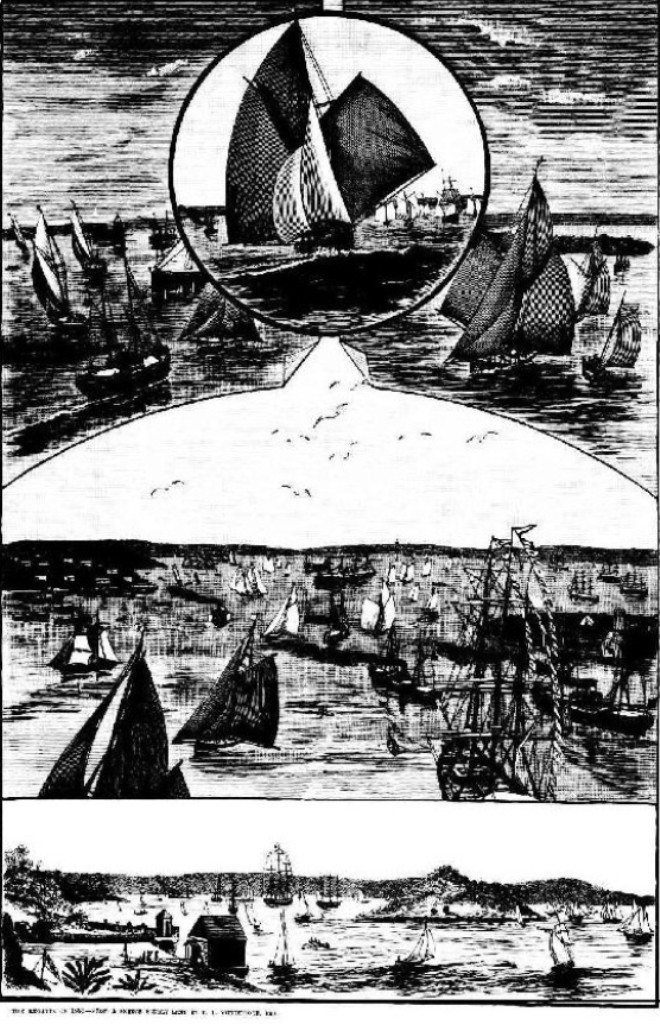 OUR National Regatta, held on the 27th ultimo, was not a new thing. The Anniversary Regatta has, for many years past, been a feature in the history of our harbour sports; and this year's display was only a stronger and brighter and more attractive edition of what had gone before. Many special points of interest distinguished this gathering, which the others, excellent as they were, had lacked. For example, additional attractiveness had been given to the prize list, chief amongst the special items introduced being the grand "Challenge Cup Yacht Race”; the trophy, valued at £500, having been presented by the Parliament of New South Wales. The weather was admirable, and the attendance enormous. The wind was extremely favourable to the full display of the capabilities of the innumerable harbour craft, and the aquatic result was worth witnessing. From an early hour the long reach of harbour, with its numberless and radiant bays and coves, was covered with boats and yachts of every description ; and the effect, as seen from the flagship, and other choice positions, was hardly to be surpassed for picturesqueness. Certainly, no preceding regatta went with the "go" which distinguished this. For some of the pulling races-notably the string-test gig and wager-boat races-the breeze was, certainly, more than a trifle too fresh, and the waves too rough. Some of the frailest boats swamped: and, after the "Senior Fours Race," the oarsmen representing the Mercantile Club were unlucky enough to get a ducking in con- sequence of their gig suddenly breaking in two. With the flocks of white-winged sailing boats, which, like seagulls, clove the face of the water, capsizing was one of the moat common events of the day ; but the crafts were, in every case, soon righted, and again set merrily skimming along ; for our amateur nautical lads are like ducks, and are hardy and venturous as Norse sailors. And, despite old Neptune's blustering behaviour, we have not heard of a single casualty.
OUR National Regatta, held on the 27th ultimo, was not a new thing. The Anniversary Regatta has, for many years past, been a feature in the history of our harbour sports; and this year's display was only a stronger and brighter and more attractive edition of what had gone before. Many special points of interest distinguished this gathering, which the others, excellent as they were, had lacked. For example, additional attractiveness had been given to the prize list, chief amongst the special items introduced being the grand "Challenge Cup Yacht Race”; the trophy, valued at £500, having been presented by the Parliament of New South Wales. The weather was admirable, and the attendance enormous. The wind was extremely favourable to the full display of the capabilities of the innumerable harbour craft, and the aquatic result was worth witnessing. From an early hour the long reach of harbour, with its numberless and radiant bays and coves, was covered with boats and yachts of every description ; and the effect, as seen from the flagship, and other choice positions, was hardly to be surpassed for picturesqueness. Certainly, no preceding regatta went with the "go" which distinguished this. For some of the pulling races-notably the string-test gig and wager-boat races-the breeze was, certainly, more than a trifle too fresh, and the waves too rough. Some of the frailest boats swamped: and, after the "Senior Fours Race," the oarsmen representing the Mercantile Club were unlucky enough to get a ducking in con- sequence of their gig suddenly breaking in two. With the flocks of white-winged sailing boats, which, like seagulls, clove the face of the water, capsizing was one of the moat common events of the day ; but the crafts were, in every case, soon righted, and again set merrily skimming along ; for our amateur nautical lads are like ducks, and are hardy and venturous as Norse sailors. And, despite old Neptune's blustering behaviour, we have not heard of a single casualty.
The magnificent "Orizaba" furnished a flagship to which no superior could have been found ; and a very distinguished company assembled at the regatta luncheon, including every Governor except Sir Henry Loch. At this, the usual felicitations were indulged in, and the usual fervent wishes expressed. The racing items of the day were all well contested-some of them astonishingly well. Very seldom indeed, for instance, has Sydney Harbour witnessed a finer race than that " Maiden Four String-test Gig Race " between the Mercantile, the Glebe, and the Sydney Rowing Clubs, which resulted in a "touch-and-go" victory for the gallant "Mercs." Kemp won the "All-comers Race" for wager boats ; but the race was not an adequate test of the capabilities of this coming oarsman. The great event of the day, the "Challenge Cup Yacht Race," was somewhat easily won by the "Era," which was ably sailed by her owner, Mr. A. G Milson. Those races, which were of an interesting and popular kind, met also with especial favour, such as the contests for merchant ships' boats, man-of-war whalers, Vernon boys, manual labour amateurs, and others. Altogether, the regatta was a most enjoyable and pleasant item in connection with our Centennial festivities. THE CENTENNIAL REGATTA. (1888, February 22). Illustrated Sydney News (NSW : 1853 - 1872), p. 8. Retrieved fromhttp://nla.gov.au/nla.news-article63620964
Vernon boys were those trained on the ship VERNON.
Although many sources state the change from 'Anniversary Day' to 'Australia Day' has been quite recent - if it has, that too has been a debate going on for a fair while longer then 'recently' and was 'officially changed' in NSW on a Monday, 8th of September, even though 'Anniversary Day' persisted as the day's name past WWII and into the 1950's:
ANNIVERSARY DAY NAME TO BE CHANGED
Anniversary Day, which has been celebrated in Sydney for more than 100 years, will no longer be observed under that name.
The State Cabinet on Monday decided to keep up the observation of the founding of the colony on January 26, 1788, under the name of Australia Day. The Premier (Mr. Lang)said the decision had been made at the request of the Australian Natives' Association. Anniversary Day was proclaimed a public holiday in 1838. In 1834 the Sydney Regatta was first conducted at Fort Macquarie. This was to become the regatta which has always been the feature of Anniversary Day, though it was not until 1842 that it was referred to as the Anniversary Regatta. As early as 1817 patriotic citizens joined in observing the day on which the colony was established. Several protests have been made against the change of name. ANNIVERSARY DAY. (1931, September 11). Narandera Argus and Riverina Advertiser (NSW : 1893 - 1953), p. 6. Retrieved from http://nla.gov.au/nla.news-article101241983
On a final note, just as the new colonists and ticket of leave convicts fobbed their noses slightly at those who would deny them basic rights and a celebration of life and their wonderful new opportunities in this new land, similarly our original custodians, the indigenous peoples of Australia, also chose this day to reassert their rights to live and live freely - and this too has been going on for a lot longer then just recently:
ABORIGINES TO HOLD DAY OF MOURNING.
During 150th Anniversary Celebrations in Melbourne, Nov. 14. Plans for the observance by aborigines throughout Australia of a day of mourning, simultaneously with the 150th anniversary celebrations in Sydney, were announced at a meeting tonight, convened by the Australian Aborigines' League.
'While white men are throwing their hats into the air with joy,' said the chairman, Mr. A. P. A. Burdue, 'aborigines will be in mourning for all they have lost. It is hoped that a day of mourning will direct the attention of the people of Australia to the desire of the aborigines for full citizen rights.'
Mr. William Ferguson, organising secretary of the Aborigines' Progressive Association of New South Wales, said: — 'Aborigines do not want protection. We have been protected for 150 years, and look what has become of us! Scientists have studied us, and written books about us, as though we were strange curiosities; but they have not prevented us from contracting tuberculosis and other diseases, which have wiped us out in thousands.' ABORIGINES TO HOLD DAY OF MOURNING. (1937, November 15). Kalgoorlie Miner (WA : 1895 - 1950), p. 3. Retrieved fromhttp://nla.gov.au/nla.news-article87472552
